2014 FIAT BRAVO Dashboard light
[x] Cancel search: Dashboard lightPage 80 of 275
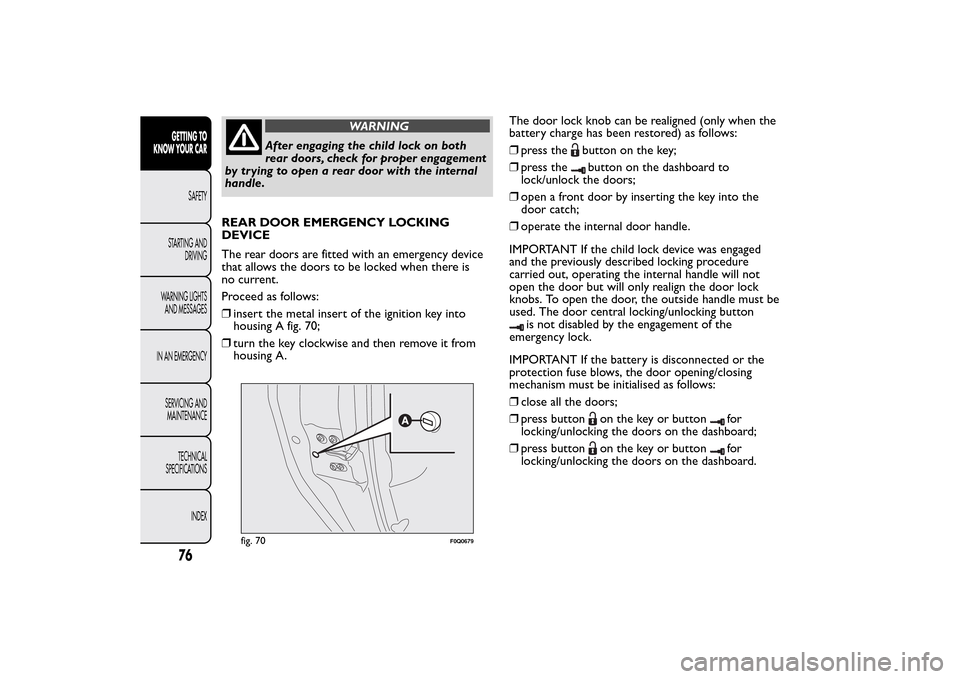
WARNING
After engaging the child lock on both
rear doors, check for proper engagement
by trying to open a rear door with the internal
handle.
REAR DOOR EMERGENCY LOCKING
DEVICE
The rear doors are fitted with an emergency device
that allows the doors to be locked when there is
no current.
Proceed as follows:
❒insert the metal insert of the ignition key into
housing A fig. 70;
❒turn the key clockwise and then remove it from
housing A.The door lock knob can be realigned (only when the
battery charge has been restored) as follows:
❒press the
button on the key;
❒press thebutton on the dashboard to
lock/unlock the doors;
❒open a front door by inserting the key into the
door catch;
❒operate the internal door handle.
IMPORTANT If the child lock device was engaged
and the previously described locking procedure
carried out, operating the internal handle will not
open the door but will only realign the door lock
knobs. To open the door, the outside handle must be
used. The door central locking/unlocking button
is not disabled by the engagement of the
emergency lock.
IMPORTANT If the battery is disconnected or the
protection fuse blows, the door opening/closing
mechanism must be initialised as follows:
❒close all the doors;
❒press button
on the key or button
for
locking/unlocking the doors on the dashboard;
❒press button
on the key or button
for
locking/unlocking the doors on the dashboard.
fig. 70
F0Q0679
76GETTING TO
KNOW YOUR CAR
SAFETY
STARTING AND
DRIVING
WARNING LIGHTS
AND MESSAGES
IN AN EMERGENCY
SERVICING AND
MAINTENANCE
TECHNICAL
SPECIFICATIONS
INDEX
Page 92 of 275
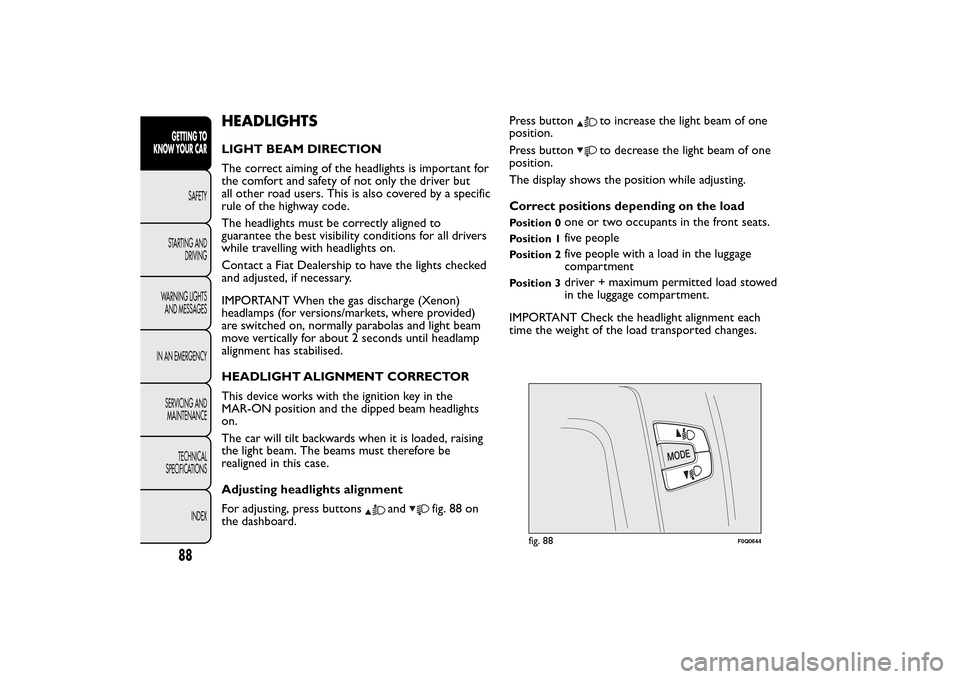
HEADLIGHTSLIGHT BEAM DIRECTION
The correct aiming of the headlights is important for
the comfort and safety of not only the driver but
all other road users. This is also covered by a specific
rule of the highway code.
The headlights must be correctly aligned to
guarantee the best visibility conditions for all drivers
while travelling with headlights on.
Contact a Fiat Dealership to have the lights checked
and adjusted, if necessary.
IMPORTANT When the gas discharge (Xenon)
headlamps (for versions/markets, where provided)
are switched on, normally parabolas and light beam
move vertically for about 2 seconds until headlamp
alignment has stabilised.
HEADLIGHT ALIGNMENT CORRECTOR
This device works with the ignition key in the
MAR-ON position and the dipped beam headlights
on.
The car will tilt backwards when it is loaded, raising
the light beam. The beams must therefore be
realigned in this case.
Adjusting headlights alignment
For adjusting, press buttons
and
fig. 88 on
the dashboard.Press button
to increase the light beam of one
position.
Press buttonto decrease the light beam of one
position.
The display shows the position while adjusting.
Correct positions depending on the load
Position 0
one or two occupants in the front seats.
Position 1
five people
Position 2
five people with a load in the luggage
compartment
Position 3
driver + maximum permitted load stowed
in the luggage compartment.
IMPORTANT Check the headlight alignment each
time the weight of the load transported changes.
fig. 88
F0Q0644
88GETTING TO
KNOW YOUR CAR
SAFETY
STARTING AND
DRIVING
WARNING LIGHTS
AND MESSAGES
IN AN EMERGENCY
SERVICING AND
MAINTENANCE
TECHNICAL
SPECIFICATIONS
INDEX
Page 97 of 275
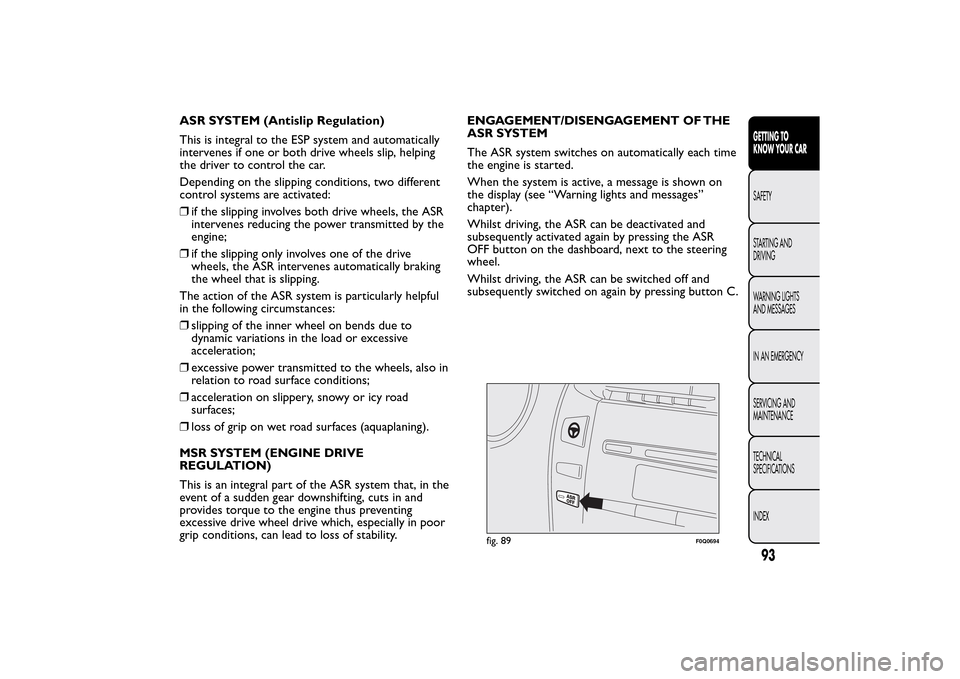
ASR SYSTEM (Antislip Regulation)
This is integral to the ESP system and automatically
intervenes if one or both drive wheels slip, helping
the driver to control the car.
Depending on the slipping conditions, two different
control systems are activated:
❒if the slipping involves both drive wheels, the ASR
intervenes reducing the power transmitted by the
engine;
❒if the slipping only involves one of the drive
wheels, the ASR intervenes automatically braking
the wheel that is slipping.
The action of the ASR system is particularly helpful
in the following circumstances:
❒slipping of the inner wheel on bends due to
dynamic variations in the load or excessive
acceleration;
❒excessive power transmitted to the wheels, also in
relation to road surface conditions;
❒acceleration on slippery, snowy or icy road
surfaces;
❒loss of grip on wet road surfaces (aquaplaning).
MSR SYSTEM (ENGINE DRIVE
REGULATION)
This is an integral part of the ASR system that, in the
event of a sudden gear downshifting, cuts in and
provides torque to the engine thus preventing
excessive drive wheel drive which, especially in poor
grip conditions, can lead to loss of stability.ENGAGEMENT/DISENGAGEMENT OF THE
ASR SYSTEM
The ASR system switches on automatically each time
the engine is started.
When the system is active, a message is shown on
the display (see “Warning lights and messages”
chapter).
Whilst driving, the ASR can be deactivated and
subsequently activated again by pressing the ASR
OFF button on the dashboard, next to the steering
wheel.
Whilst driving, the ASR can be switched off and
subsequently switched on again by pressing button C.
fig. 89
F0Q0694
93GETTING TO
KNOW YOUR CARSAFETY
STARTING AND
DRIVING
WARNING LIGHTS
AND MESSAGES
IN AN EMERGENCY
SERVICING AND
MAINTENANCE
TECHNICAL
SPECIFICATIONS
INDEX
Page 99 of 275

EOBD SYSTEMThe EOBD system (European On Board Diagnostic)
is a diagnosis system installed on the ECUs, which
detects and reports possible malfunctions in the
electronic systems that could worsen emissions.
The goal of the system is to:
❒monitor the system efficiency;
❒indicate an increase in emissions due to vehicle
malfunction;
❒indicate the need to replace components which
have deteriorated.
It also alerts the driver, by turning on the warning
light
on the instrument panel (together with
relevant message on the display), when these
components are damaged; it can also report any
system malfunctions (see "Warning lights and
messages" chapter).
Note The car also has a connector that can be
interfaced with appropriate tools, which makes it
possible to read the error codes stored in the
electronic control units together with a series of
specific parameters for engine operation and
diagnosis. This check can also be carried out by the
traffic police.
IMPORTANT After an operation at the Fiat
Dealership, aimed at solving malfunctions linked to
the EOBD system, some bench tests should be
made, along with road tests if necessary, for a
complete check of the system. The latter may also
require the car to cover a long distance.
WIRING FOR RADIO SYSTEM(for versions/markets, where provided)
The car may be equipped with a storage
compartment on the dashboard.
The radio must be installed in the place occupied by
the central storage compartment A fig. 90, where
you will find the wiring.
Press on the retaining devices under the central
storage compartment to extract the compartment.
WARNING
For connection to the radio system
set-up, contact a Fiat Dealership
to prevent any problem that could impair car
safety.
fig. 90
F0Q0691
95GETTING TO
KNOW YOUR CARSAFETY
STARTING AND
DRIVING
WARNING LIGHTS
AND MESSAGES
IN AN EMERGENCY
SERVICING AND
MAINTENANCE
TECHNICAL
SPECIFICATIONS
INDEX
Page 101 of 275
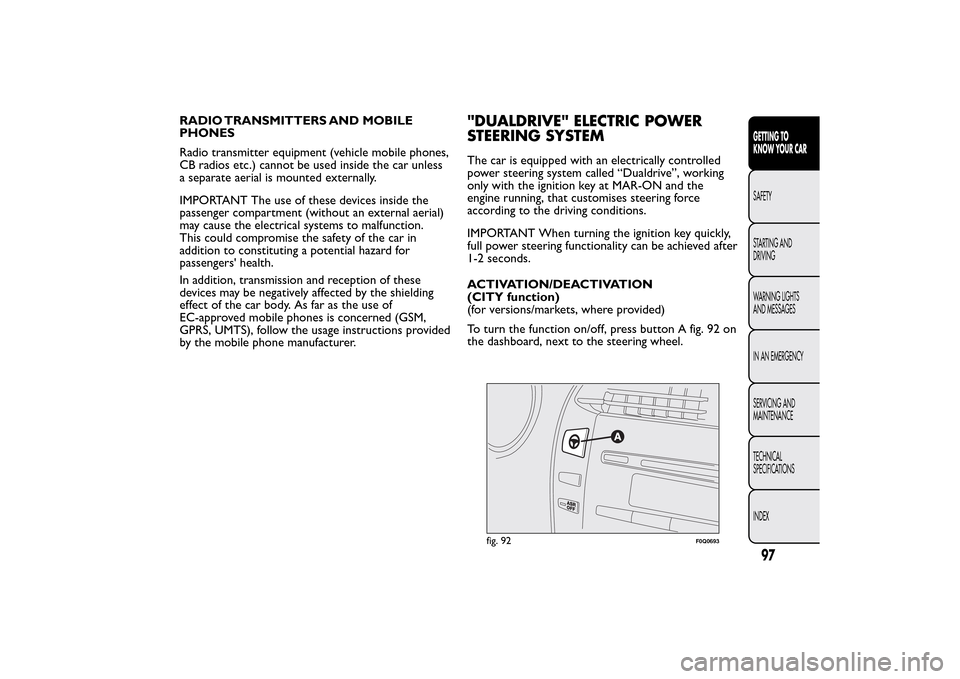
RADIO TRANSMITTERS AND MOBILE
PHONES
Radio transmitter equipment (vehicle mobile phones,
CB radios etc.) cannot be used inside the car unless
a separate aerial is mounted externally.
IMPORTANT The use of these devices inside the
passenger compartment (without an external aerial)
may cause the electrical systems to malfunction.
This could compromise the safety of the car in
addition to constituting a potential hazard for
passengers' health.
In addition, transmission and reception of these
devices may be negatively affected by the shielding
effect of the car body. As far as the use of
EC-approved mobile phones is concerned (GSM,
GPRS, UMTS), follow the usage instructions provided
by the mobile phone manufacturer.
"DUALDRIVE" ELECTRIC POWER
STEERING SYSTEMThe car is equipped with an electrically controlled
power steering system called “Dualdrive”, working
only with the ignition key at MAR-ON and the
engine running, that customises steering force
according to the driving conditions.
IMPORTANT When turning the ignition key quickly,
full power steering functionality can be achieved after
1-2 seconds.
ACTIVATION/DEACTIVATION
(CITY function)
(for versions/markets, where provided)
To turn the function on/off, press button A fig. 92 on
the dashboard, next to the steering wheel.
fig. 92
F0Q0693
97GETTING TO
KNOW YOUR CARSAFETY
STARTING AND
DRIVING
WARNING LIGHTS
AND MESSAGES
IN AN EMERGENCY
SERVICING AND
MAINTENANCE
TECHNICAL
SPECIFICATIONS
INDEX
Page 109 of 275

ACOUSTIC SIGNAL
The information concerning the presence and
distance of an obstacle from the vehicle is
transmitted by means of acoustic signals from
buzzers installed in the passenger compartment:
❒in the versions with 4 rear sensors, a buzzer in the
front dashboard area warns of the presence of rear
obstacles;
❒in the versions with 8 sensors (4 front and 4 rear
sensors), a front buzzer warns of the presence of
obstacles at the front and a buzzer located at
the rear warns of the presence of obstacles at the
rear. This notifies the driver of the direction
(front/rear) of the obstacles.
When reverse gear is engaged an intermittent
acoustic signal is automatically activated.
The acoustic signal:
❒increases as the distance between the car and the
obstacle decreases;
❒becomes continuous when the distance between
the car and the obstacle is less than 30 cm and
stops immediately if the distance increases;
❒remains constant if the distance remains
unchanged; if this situation concerns the side
sensors, the buzzer will stop after about 3 seconds
to avoid, for example, warning indications in the
event of manoeuvres along walls.
WARNING
For correct operation, sensors must
always be clean from mud, dirt , snow or
ice. Be careful not to scratch or damage the
sensors while cleaning them. Avoid using dry,
rough or hard cloths.The sensors should be
washed using clean water with the addition of
car shampoo if necessary. In washing stations,
clean sensors quickly keeping the vapour
jet/high pressure washing nozzles at 10 cm at
least from the sensors.
WARNING
Only have the bumpers repainted or any
retouches to the paintwork in the area
of the sensors carried out by a Fiat Dealership.
Incorrect paint application could affect the
operation of the parking sensors.
105GETTING TO
KNOW YOUR CARSAFETY
STARTING AND
DRIVING
WARNING LIGHTS
AND MESSAGES
IN AN EMERGENCY
SERVICING AND
MAINTENANCE
TECHNICAL
SPECIFICATIONS
INDEX
Page 130 of 275
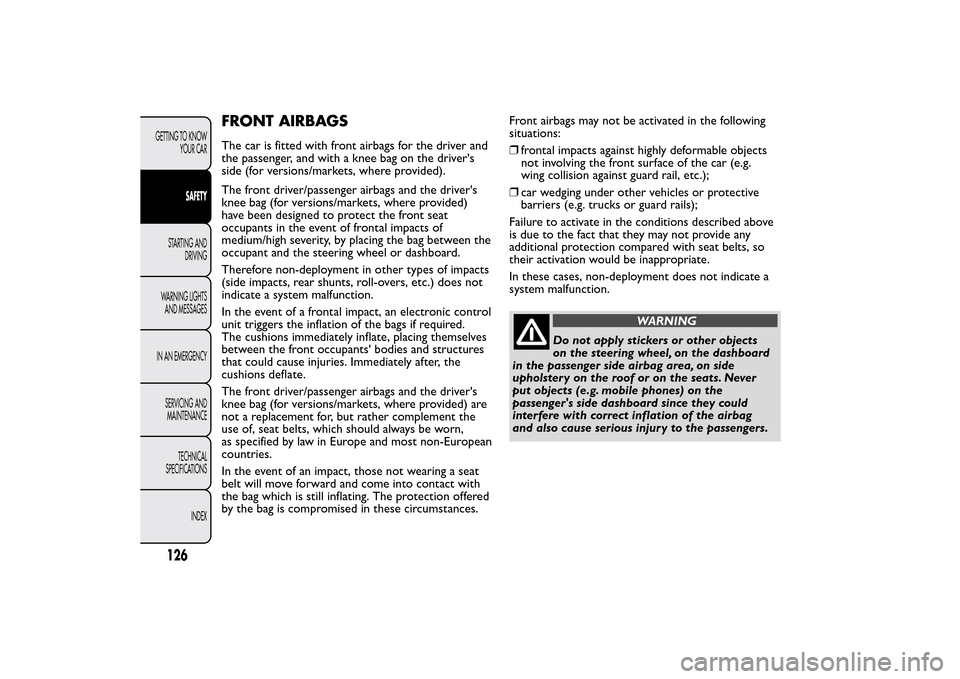
FRONT AIRBAGSThe car is fitted with front airbags for the driver and
the passenger, and with a knee bag on the driver's
side (for versions/markets, where provided).
The front driver/passenger airbags and the driver's
knee bag (for versions/markets, where provided)
have been designed to protect the front seat
occupants in the event of frontal impacts of
medium/high severity, by placing the bag between the
occupant and the steering wheel or dashboard.
Therefore non-deployment in other types of impacts
(side impacts, rear shunts, roll-overs, etc.) does not
indicate a system malfunction.
In the event of a frontal impact, an electronic control
unit triggers the inflation of the bags if required.
The cushions immediately inflate, placing themselves
between the front occupants' bodies and structures
that could cause injuries. Immediately after, the
cushions deflate.
The front driver/passenger airbags and the driver's
knee bag (for versions/markets, where provided) are
not a replacement for, but rather complement the
use of, seat belts, which should always be worn,
as specified by law in Europe and most non-European
countries.
In the event of an impact, those not wearing a seat
belt will move forward and come into contact with
the bag which is still inflating. The protection offered
by the bag is compromised in these circumstances.Front airbags may not be activated in the following
situations:
❒frontal impacts against highly deformable objects
not involving the front surface of the car (e.g.
wing collision against guard rail, etc.);
❒car wedging under other vehicles or protective
barriers (e.g. trucks or guard rails);
Failure to activate in the conditions described above
is due to the fact that they may not provide any
additional protection compared with seat belts, so
their activation would be inappropriate.
In these cases, non-deployment does not indicate a
system malfunction.
WARNING
Do not apply stickers or other objects
on the steering wheel, on the dashboard
in the passenger side airbag area, on side
upholstery on the roof or on the seats. Never
put objects (e.g. mobile phones) on the
passenger's side dashboard since they could
interfere with correct inflation of the airbag
and also cause serious injur y to the passengers.
126GETTING TO KNOW
YOUR CAR
SAFETY
STARTING AND
DRIVING
WARNING LIGHTS
AND MESSAGES
IN AN EMERGENCY
SERVICING AND
MAINTENANCE
TECHNICAL
SPECIFICATIONS
INDEX
Page 131 of 275
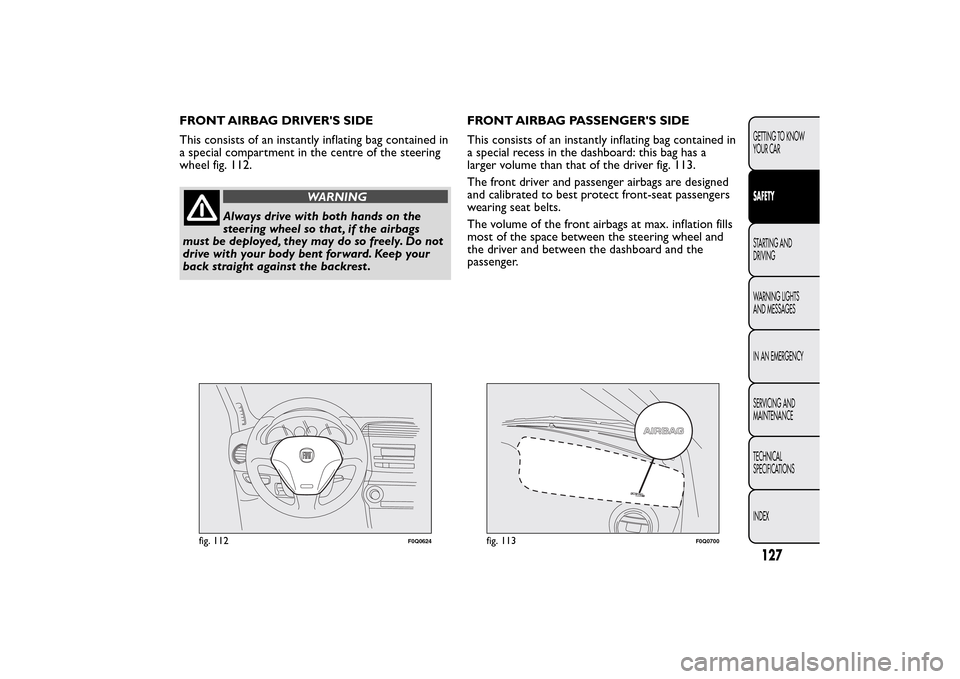
FRONT AIRBAG DRIVER'S SIDE
This consists of an instantly inflating bag contained in
a special compartment in the centre of the steering
wheel fig. 112.
WARNING
Always drive with both hands on the
steering wheel so that , if the airbags
must be deployed, they may do so freely. Do not
drive with your body bent forward. Keep your
back straight against the backrest .FRONT AIRBAG PASSENGER'S SIDE
This consists of an instantly inflating bag contained in
a special recess in the dashboard: this bag has a
larger volume than that of the driver fig. 113.
The front driver and passenger airbags are designed
and calibrated to best protect front-seat passengers
wearing seat belts.
The volume of the front airbags at max. inflation fills
most of the space between the steering wheel and
the driver and between the dashboard and the
passenger.
fig. 112
F0Q0624
fig. 113
F0Q0700
127GETTING TO KNOW
YOUR CARSAFETYSTARTING AND
DRIVING
WARNING LIGHTS
AND MESSAGES
IN AN EMERGENCY
SERVICING AND
MAINTENANCE
TECHNICAL
SPECIFICATIONS
INDEX